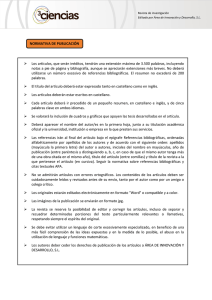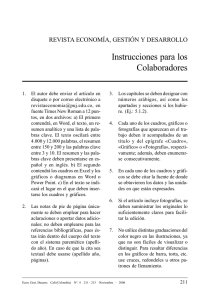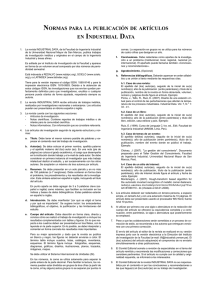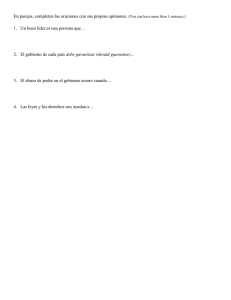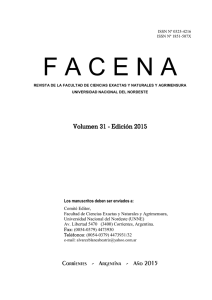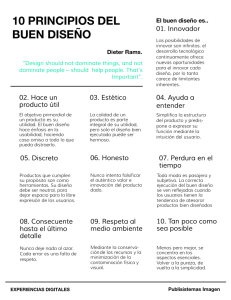Nor mas Edi to ria les
Anuncio
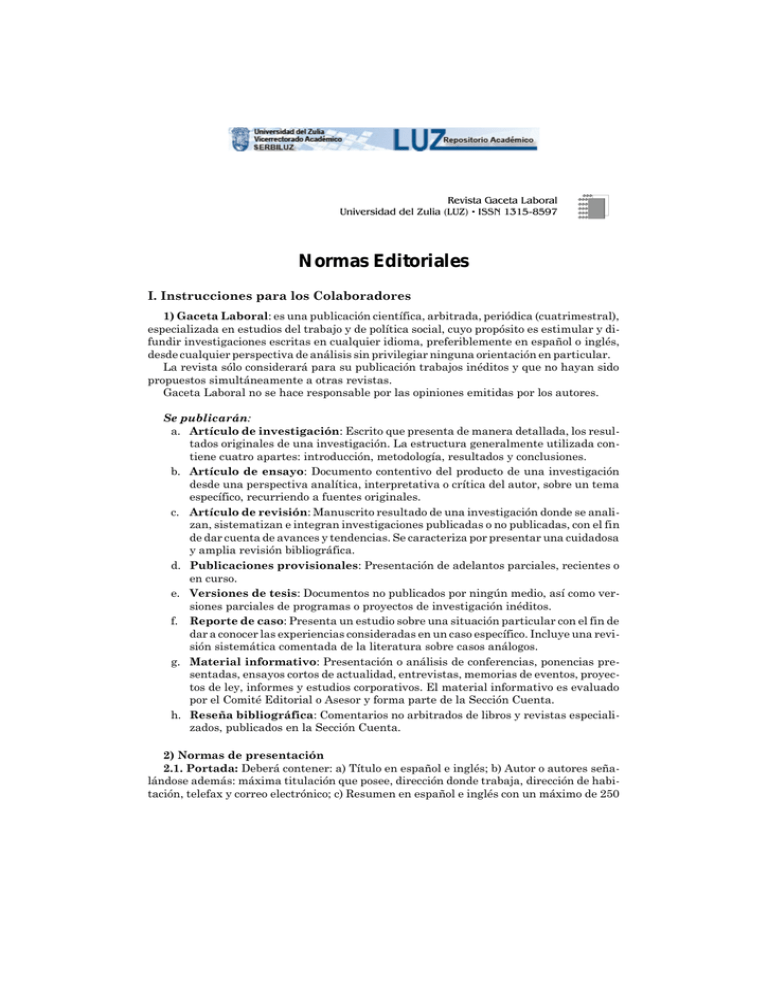
Revista Gaceta Laboral Universidad del Zulia (LUZ) · ISSN 1315-8597 Normas Editoriales I. Instrucciones para los Colaboradores 1) Gaceta Laboral: es una publicación científica, arbitrada, periódica (cuatrimestral), especializada en estudios del trabajo y de política social, cuyo propósito es esti mular y difundir investigaciones escritas en cualquier idioma, preferiblemente en español o inglés, desde cualquier perspectiva de análisis sin privilegiar ninguna orientación en parti cular. La revista sólo considerará para su publicación trabajos inéditos y que no hayan sido propuestos simultáneamente a otras revistas. Gaceta Laboral no se hace responsable por las opiniones emitidas por los autores. Se publicarán: a. Artículo de investigación: Escrito que presenta de manera detallada, los resultados originales de una investigación. La estructura generalmente utilizada contiene cuatro apartes: introducción, metodología, resultados y conclusiones. b. Artículo de ensayo: Documento contentivo del producto de una investigación desde una perspectiva analítica, interpretativa o crítica del autor, sobre un tema específico, recurriendo a fuentes originales. c. Artículo de revisión: Manuscrito resultado de una investigación donde se analizan, sistematizan e integran investigaciones publicadas o no publicadas, con el fin de dar cuenta de avances y tendencias. Se caracteriza por presentar una cuidadosa y amplia revisión bibliográfica. d. Publicaciones provisionales: Presentación de adelantos parciales, recientes o en curso. e. Versiones de tesis: Documentos no publicados por ningún medio, así como versiones parciales de programas o proyectos de investigación inéditos. f. Reporte de caso: Presenta un estudio sobre una situación particular con el fin de dar a conocer las experiencias consideradas en un caso específico. Incluye una revisión sistemática comentada de la literatura sobre casos análogos. g. Material informativo: Presentación o análisis de conferencias, ponencias presentadas, ensayos cortos de actualidad, entrevistas, memorias de eventos, proyectos de ley, informes y estudios corporativos. El material informativo es evaluado por el Comité Editorial o Asesor y forma parte de la Sección Cuenta. h. Reseña bibliográfica: Comentarios no arbitrados de libros y revistas especializados, publicados en la Sección Cuenta. 2) Normas de presentación 2.1. Portada: Deberá contener: a) Título en español e inglés; b) Autor o autores señalándose además: máxima titulación que posee, dirección donde trabaja, dirección de habitación, telefax y correo electrónico; c) Resumen en español e inglés con un máximo de 250 palabras, el cual incluirá objetivos, metodología, resultados y conclusiones rele vantes; y d) Palabras clave en español e inglés en un número no mayor de cinco (5) para facilitar la indización y clasificación bibliográfica. 2.2. Cuerpo del Trabajo: Debe dividirse en introducción, desarrollo y conclusiones. La extensión del Trabajo no será mayor de veinticinco (25) cuartillas incluyendo las notas, tablas, gráficos, ilustraciones y referencias bibliográficas. Los manuscritos no po drán contener fotografías ni ningún tipo de imágenes. 2.3. Modo de citar: Los comentarios y notas al pie de página sólo serán utilizados para realizar alguna explicación adicional e irán numerados consecutivamente y a un (1) espacio. Las referencias correspondientes a fuentes publicadas tanto en medios impresos como electrónicos (internet) se incluirán en el cuerpo del trabajo mediante el sistema “Harvard”, escribiendo entre paréntesis el apellido del autor o autores, seguido de coma y el año, ej. (Mesa-Lago, 2003). Cuando se trate de una cita textual, debe colocarse el número de la página de la cual se tomó inmediatamente después de la fecha, separado por dos puntos, ej. (Mesa-Lago, 2003: 45-46). Si hay varias obras del mismo autor publicadas en el mismo año, se mantiene el orden cronológico, diferenciándose las referencias utilizando letras, ej. (Mesa-Lago, 2003a) y (Mesa-Lago, 2003b). Las citas textuales de más de cinco (5) líneas serán incluidas en párrafo aparte a un solo espacio y con doble sangría. En estas citas no será necesario usar comillas. Las citas y/o referencias a comunicaciones personales escri tas (cartas, oficios, correos electrónicos), las exposiciones orales (conferencias, declaraciones públicas, etc.) y las comunicaciones personales orales (conversaciones y entrevistas) serán presentadas conforme a las mismas normas. 2.4. Referencias bibliográficas: Se colocarán al final del texto ordenadas alfabética y cronológicamente, incluyéndose solamente las efectivamente citadas. En el caso de señalar varios textos de un mismo autor individual o colectivo, las referencias se ordenarán entre sí por el año de su publicación, colocando el más antiguo en primer lugar. Si dos (2) o más trabajos de un mismo autor (individual o colectivo) tienen el mismo año de publicación, se añadirá a éste un código alfabético (a, b, c,…) y se ordenarán entre sí siguiendo dicho código, por ej.: 1995a, 1995b, 1995c, etc. La bibliografía se desglosará de la siguien te manera: - Libros: APELLIDOS, Nombre (Año). Título. Edición. Lugar de edición. Editorial. VILLASMIL PRIETO, Humberto (2001). Estudios de Derecho del Trabajo. Caracas. Universidad Católica Andrés Bello. - Libro con coordinador (es): APELLIDOS, Nombre (Año). “Título del Capítulo”. En: APELLIDOS, Nombre del coordinador (es). Título. Lugar de Edición. Editorial. Páginas del libro en el que se encuentra el capítulo. JAIME MARTÍNEZ, Héctor (1999). “Título I Normas Fundamentales”. En: HERNÁNDEZ A., Oscar (Coordinador). Comentarios a la Ley Orgánica del Trabajo. Barquisimeto. Tipografía Horizonte. pp 9-63. - Artículo en revista: APELLIDOS, Nombre (Año). “Título del artículo”. En: Título de la publicación en serie. Lugar de edición. Editorial, Volumen, Número, páginas. BERNARDONI DE GOVEA, María (2003). “La contratación colectiva de trabajo. Dificultades y expectativas”. En: Gaceta Laboral. Maracaibo. Universidad del Zulia. Centro de Investigaciones y Estudios Laborales y Disciplinas Afines. Ediciones Astro Data. Vol. 9, No. 1, pp 42-63. - Ponencia: APELLIDOS, Nombre (Año). “Título”. Nombre del evento. Lugar de celebración. Fecha. HERNÁNDEZ G., Nelexys (2004). “Retos laborales frente a la globalización”. XV Congreso Nacional de Derecho del Trabajo y de la Seguridad Social. Santo Domingo, República Dominicana. 17 al 19 de Noviembre de 2004. - Documentos no publicados: APELLIDOS, Nombre (Año). Título del trabajo. Trabajo no publicado. Lugar donde se encuentra. Ciudad. País. HERNÁNDEZ G., Nelexys (2005). Modificación in peius de las condiciones de trabajo. Trabajo no publicado. Centro de Investigaciones y Estudios Laborales y Disciplinas Afines. Maracaibo. Venezuela. - Fuentes electrónicas: APELLIDOS, Nombre (del autor si se conoce). (Año). Título. Página web, día, mes y año de la consulta BARREIRO, Raquel (2004). Venezuela con la Inflación más alta en América. En: http://www.eluniversal.com. Fecha de Consulta: 26/08/2004 3) Consejo Editorial: 3.1. Las solicitudes o propuestas de publicación deben ir acompañadas de una carta dirigida al Consejo Editorial, y un breve currículo del autor (es). 3.2. Los trabajos que el Consejo Editorial estime apropiados para su publicación y que cumplan los requisitos indicados, serán sometidos al arbitraje de especialistas en el área temática de la revista, es decir, estudios del trabajo y política social, quienes se regirán por la Planilla de Evaluación y por las Instrucciones para los Colaboradores de Gaceta La boral. Los artículos que no presenten todos los requisitos serán devueltos y por lo tanto no serán sometidos a arbitraje. No se devuelven originales. Cada trabajo será dictaminado por dos (2) o tres (3) revisores, siguiendo el sistema de doble ciego. 3.3. El Consejo Editorial está facultado para realizar modificaciones de forma al manuscrito, una vez que sea aprobado por los árbitros especialistas. El autor acepta la inclusión de su creación en índices, bases de datos y enlaces en la WEB, gratuitos o por suscripción. 3.4. No están permitidas las colaboraciones de un mismo autor en números consecutivos de Gaceta Laboral. En caso de aprobarse un artículo cuyo autor(es) se encuentren en la situación indicada, el Consejo Editorial se reserva el derecho de decidir el número de la revista en el que será publicado, lo cual será notificado al(los) autor(es). 3.5. Los autores de los trabajos publicados recibirán un (1) ejemplar del Número de la Revista en la que aparece y diez (10) separatas del artículo. 3.6. El tiempo promedio para notificar el resultado de la evaluación será de tres meses. 3.7. Las propuestas deben ser enviadas en original y dos (2) copias, éstas últimas sin identificación del autor e institución de afiliación, acompañadas de un (1) CD en Word para Windows al apartado postal 10.432, Maracaibo, Venezuela; o como documento adjunto al correo electrónico: [email protected] / [email protected] II. Instrucciones para los Evaluadores 1. Se considerarán los siguientes aspectos: Pertinencia del trabajo para la especiali dad de la revista, adecuación del título, resumen y palabras clave, desarrollo coherente del contenido, organización de secciones, objetividad del enfoque, dominio del tema, aportes al conocimiento del objeto, calidad en el tratamiento y actualidad de las fuentes, presentación de conclusiones y recomendaciones, tablas y gráficos, y finalmente, apreciación general. Se usarán cuatro escalas (Excelente, Bueno, Regular y Deficiente), debiendo el revisor justificar la calificación otorgada en cada uno de los ítems que aparecen en la planilla corres pondiente. El especialista debe verificar si el trabajo cumple con las instrucciones para los colaboradores de la revista, pudiendo emitir su opinión sobre la redacción y la ortografía en un lapso promedio de cuarenta y cinco (45) días. 2. Como resultado de las evaluaciones se tomará una de las siguientes decisiones sobre el trabajo: - Aceptación inmediata para publicar sin cambios. - Aceptación con ligeras modificaciones, en el entendido que el manuscrito deberá ser ajustado de acuerdo a las observaciones de los revisores. - Aceptación con modificaciones sustanciales, para lo cual el autor tendrá un plazo máximo de tres (3) meses para realizar las correcciones sugeridas por los expertos. - El trabajo es rechazado sin opción de reenviar una nueva versión. En todo caso, la decisión del árbitro debe estar fundamentada y explicar claramente las observaciones y sugerencias que considere oportunas, las cuales serán remitidas al autor o autores. Revista Gaceta Laboral Universidad del Zulia (LUZ) · ISSN 1315-8597 Editorial Norms I. Instructions for authors of articles 1) Gaceta Laboral: is an arbitrated scientific publication published quarterly, which specializes in social work and social policy. The purpose of the publication is to stimulate and publish scientific publications written in any language, but preferibly in Spanish or English, from any analytical perspective, and promotes no particular orientation or school of thought. The publication only considers un-edited papers, which have not been simultaneously offered to other journals, for publication. Gaceta Laboral does not accept responsibility for opinions emitted by the authors. The following texts are acceptable for publication: a. Research reviews: Paper that present detailed information on original research results. Articles to be published should be structured in the following manner: introduction, methodology, results, and conclusions. b. Essays: Documents refering to the product of original research from an analytical, interpretive or critical perspective, in relation to a specific theme and based on original sources. c. Reviews: Articles that result from published or unpublished research which has been analyzed, systematized or integrated, in order to offer research advances and tendencies. The articles normally present carefully organized and lengthy bibliographical reviews. d. Provisional publications: The presentation of partial or recent advances in ongoing research. e. Thesis versions: Published or unpublished documents, such as partial versions of unedited research projects or programs. f. Case reports: The presentation of a study of a particular situation for the purpose of relating experiences to be considered. This includes systematic commentated reviews from literature in relation to analogous situations. g. Informative reports: The presentation or analysis of: conferences, research results, short essays, reports on events, proposed laws, or corporative studies and reviews. This informative material is evaluated by the Editorial Committee or Advisor and forms part of the Informative Section. h. Bibliographical reviews: Non-arbitrated comments on specialized books and journals, published in the Informative Section. 2) The Norms for the presentation of articles: 2.1. Cover Page: This should include: a) the title in Spanish and English; b) the names of the autor(s) including the highest academic degree obtained, work address, home address, tele-fax and E-mail addresses; c) a maximum 250 word abstract in English and in Spanish, which should include the objectives of the study, the methodology, the results and relevant conclusions; and d) Key words in both English and Spanish (maximum 5 words) in order to facilitate bibliographical indexation and classification. 2.2. The main body of the paper: This should be divided into introduction, development and conclusions.The paper should not exceed twenty-five (25) pages including notes, tables, graphs, illustrations and bibliography. Manuscripts should not contain photographs or any types of images. 2.3. Bibliographical references: Commentaries and foot notes should only be used in order to introduce an additional explanation, and should be numbered consecutively and single spaced. References to published sources such as printed and electronic (internet) sources should be included in the body of the text using the Harvard system, by writing in parenthesis the last names of the authors, followed by a comma and the year, ex. (MesaLago, 2003). When the quote is direct, the page number should also be included after the date, separated by a colon, ex. (Mesa-Lago, 2003: 45-46). If there are various articles by the same autor in the same year, they should be ordered chronologically, and differentiated by by small letters, ex: (Mesa-Lago, 2003a) and (Mesa-Lago, 2003b). Direct quotations of texts over five (5) lines should be included in a separate paragraph single-spaced with double- indented margins. These quotations do not necessarily need quotation marks. Quotations and references to personal communications (letters, official communications, and email messages), oral expositions (conferences, public declarations, etc.) and personal oral communications (conversations and interviews) should be presented according to the same rules and norms. 2.5. Bibliographical References: Bibliographical references should be placed at the end of the text in alphabetical and chronological order, including only what has been quoted directly. In cases where there are several texts by the same author(s), the references should be ordered by publication year, placing the earliest quotation first. If two (2) or more texts from the same autor(s) have the same year of publication, place the earlier publication first. If two or more articles from the same author(s) appear in the same year, an alphabetical code should be added (a, b. c…) and the articles ordered in the following manner, for example: 1995a, 1995b, 1995c, etc. The bibliography should ordered in the following manner: - Books: LAST NAME, First name (year). Title. Place of publication, Publisher or Editorial. VILLASMIL PRIETO, Humberto (2001). Estudios de Derecho del Trabajo. Caracas. Universidad Católica Andrés Bello. - Books with an Coordinator or Compiler: LAST NAME(S), First name (Year). “Title of Chapter”. In: LAST NAME , Name of coordinator(s). Title. City or place where edited. Printer. Pages of the book where the chapter appears. JAIME MARTÍNEZ, Héctor (1999). “Título I Normas Fundamentales”. En: HERNÁNDEZ A., Oscar (Coordinador). Comentarios a la Ley Orgánica del Trabajo. Barquisimeto. Tipografía Horizonte. pp 9-63. - Article in Journal: LAST NAME(S), Name (Year). “Title of Article”. In: Name of the Publication, City or place where edited: Editor or printer, Volume, Number, pages. BERNARDONI DE GOVEA, María (2003). “La contratación colectiva de trabajo. Dificultades y expectativas”. En: Gaceta Laboral. Maracaibo. Universidad del Zulia. Centro de Investigaciones y Estudios Laborales y Disciplinas Afines. Ediciones Astro Data. Vol. 9, No. 1, pp 42-63. - Presentations: LAST NAME(S), First name(s) (Year). “Title”. Name of Event. Place. Date. HERNÁNDEZ G., Nelexys (2004). “Retos laborales frente a la globalización”. XV Congreso Nacional de Derecho del Trabajo y de la Seguridad Social. Santo Domingo, República Dominicana. 17 al 19 de Noviembre de 2004. - Unpublished documents: LAST NAME(S), First Name(s) (Year). Title of document. Unpublished document. Institution where document was found. City. Country. HERNÁNDEZ G., Nelexys (2005). Modificación in peius de las condiciones de trabajo. Trabajo no publicado. Centro de Investigaciones y Estudios Laborales y Disciplinas Afines. Maracaibo. Venezuela. - Electronic sources: LAST NAME(S), First name(s) (of autor if known). (Year). Title. Web site, day, month and year when consulted. BARREIRO, Raquel (2004). Venezuela con la Inflación más alta en América. En: http://www.eluniversal.com. Fecha de Consulta: 26/08/2004. 3) Editorial recommendations: 3.1. Publication requests or proposals should go directly the Editorial Board together with a letter addressed to the same and a brief curriculum vitae of the author(s). 3.2. Papers the Editorial Board esteem to be appropriate for publication, and which fulfill all of the requirements, will be subjected to arbitration by specialists in the corresponding thematic area of the journal. For example, studies on labor and social policy will be submitted to evaluation by experts in this area according to the Evaluation Format and instructions for authors in Gazeta Laboral. Articles which do not comply with all the requirements will be returned and not sent to arbitration. Original copies will not be returned. Each paper will be judged by two or three different and independent reviewers unknown to each other. 3.3. The Editorial Board is authorized to modify the format of manuscripts, once they have been approved in arbitration by specialized experts. The author accepts inclusion of his creation in indexes, data bases and web links, either free or by subscription. 3.4. The same author(s) will not be allowed to participate in consecutive numbers of the Gaceta Laboral. If an article is approved whose author finds him/herself in the situation indicated, the Editorial Council reserves the right to decide in which number of the journal the author(s) will be published, and the author(s) will be notified to that effect. 3.5. Authors of published papers will receive one copy of the journal in which the article appears and 10 separate printed copies of the article. 3.6. The average time lapse for notification of acceptance or not is three months. 3.7. One complete original copy, and two additional copies without the names of the authors or institution involved, along with computerized copy on a CD in Word for Windows should be sent to P.O. Box 10.432, Maracaibo Venezuela, or by E-mail attachment to there following address: [email protected] / [email protected] II. Instructions for Evaluators 1. The following aspects should be considered: the pertinence of the paper in relation the the specialized area of the journal, the appropriateness of the title, the abstract and key words, the coherence of the content, the organization of the sections of the article, objectivity in the focus of the paper, author´s knowledge of the field, the contribution to the field, the quality of the analysis and timeliness of the sources consulted, the presentation of conclusions and recommendations, tables and graphs, and finally the overall quality and evaluation of the article. Four grade scales will be applied (Excellent, Good, Aceptable, Deficient) , and the arbiters must justify the final grade based on each of the items that appear on the evaluation sheet. The specialist/arbitor should verify whether or not the paper complies with the instructions for the presentation of papers or not, and may comment on writing style and grammar within a lapse of not longer than forty-five (45) days. 2. Based on the results of the evaluation, one of the following decisions will be taken: - Immediate acceptance for publication without modification. - Acceptance for publication with minor modifications according to the instructions and observations of arbiters. - Acceptance but with major modifications, in which the autor(s) will have a period of three (3) months in which to comply with the corrections indicated by the arbiters. - Rejection of the article without option to correct and submit the same again. In all cases, the decisions of the arbiters should be clearly argued and explained, and based on relevant observations and suggestions, and will be sent to the autor(s).
